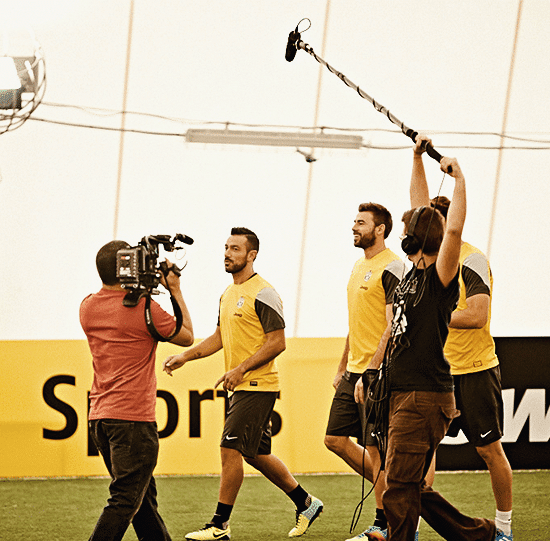How to Get Started in Sports Filmmaking
Sports filmmaking is a highly competitive field that many aspiring filmmakers want to get started in. While the process can be challenging, it is ultimately an exciting and rewarding journey. As for any activity, it is best to get in with as much preparation as possible.
Why Sports Filmmaking Matters
Below, we have compiled a concise list of essential steps to cover the basics of sports filmmaking and sports videography tips that cover the importance of sports filmmaking.
Choosing the Right Equipment
No matter how high the equipment quality might be, it will mostly be down to one’s skills and knowledge. However, a high-spec camera and a solid tripod are helpful items to invest in! Sports are typically fast-paced and precise: to capture as many details of a movement as possible, you’ll need a camera with a high capacity for frames per second. For example, sports broadcasted on TV are shot at 30 FPS. Higher FPS like 60 or 120 can allow you to slow down the footage and have high-quality-looking slow-motion shots, which is always a plus.
Once you’ve set your heart on a sports videography camera, the next step is lenses. There are many lenses out there, ranging from macro zooms to wide angles, opening the door to countless creative ideas. Which one you choose will depend on the direction the project needs to take. To cut down on budget, remember to check for rental services!
Essential Skills for Sports Filmmakers
The skills needed for filming sports will, of course, depend on the sport itself. Filmmaking techniques for football won’t apply as successfully to water polo. But here’s a general tip: get better at anticipating. Especially in team-based sports, you’ll need to follow multiple people from multiple angles, all reacting to one another.
It can quickly get messy if there’s not enough preparation. Therefore, it is essential to familiarise yourself with the sport’s rules and basic strategies. Once you have a deeper understanding of what exactly it is that the athletes are doing, you’ll be able to document their journey more closely. It will also prove valuable when it comes to editing.
Editing is all about rhythm and balance. You’ll want variety in your shots to keep the viewers hooked and entertained. In the end, a sports videographer needs to be quick on their toes, capable of making quick decisions to never miss a beat and adapt to new situations fast.
On-Field Filming Techniques
Sports videographers need unique skills to excel in their craft, including an array of mastered filming techniques. Depending on your project, you’ll need to focus on the analytical or emotional side of sports. Are you following an up-and-coming athlete? You might want zoom lenses to get up close or use a handheld filming technique to translate the rawness/newness of the situation.
Are you filming an experienced professional showcasing their talent? You might want more slow-motion tracking shots to allow the viewers to really analyse their movements. Proficiency in a wide range of shots will help based on your project’s specific needs. Once again, variety is key to letting the edit breathe and feel natural; you’ll need close-ups and wide shots. Static shots will contrast with a faster-paced tracking shot. A dynamic approach is best, as it will leave you with a more engaging film.
Challenges in Sports Filmmaking
Any sports filmmaking job comes with challenges, and your ability to overcome them could lead to further opportunities in the future. Those sets of challenges will vary from one sport to another. However, all professional athletes are busy individuals, and chances are you’ll have less time with them than you would with an actor.
Preparation will be key, as well as your quick thinking. Control what you can control: make sure the equipment is ready, the set too, if there’s one, and potentially your crew. Be ready to welcome a stressed out, maybe uncomfortable athlete who needs guidance. Beyond your technical skills, your human skills will also be necessary.
One of your main challenges will be dealing with competition. Find out how to stand out in the sports video world. Experiment with new ways of filming/editing sports that will grab people’s attention. Identify your weaknesses and train to overcome them. Hands-on experience is the best to learn how to overcome challenges, so don’t be afraid to try just for the sake of it.
Career Opportunities in Sports Filmmaking
Many would be quick to say that filmmaking is easier than ever, what with the current generalised access to technology. And as true as that statement might be, it also comes with the fact that the pool of sports videographers is larger than ever. Per the last point, standing out will be a main challenge in this career path. Contacting agencies and production companies with your portfolio is encouraged, as is building connections and making a name for yourself.
However, there are other ways to market your talents, thanks to our never-ending technological growth: social media. Many freelancers have found jobs through online platforms. Post your work online – on social media or your website, as this will help promote yourself, your personal style and your creativity. It also serves as a more relaxed space to express yourself. You can casually document your creative process, post about your influences, build an authentic following and access new sports and media jobs.
Connect with Mob Sport for Sports Filmmaking
With more than 25 years of experience, our team has delivered award-winning sports commercials as well as documentaries for giants of the industry. We regularly collaborate with numerous renowned professionals in a wide range of sports: football, boxing, formula, golf and much more.
Our diverse experience has allowed us to become a leading production company in sports content. Browse our videos for examples of our work, and get in touch with Mob Sport.
Tags: Film and Production , football , Mob Sport , video production

